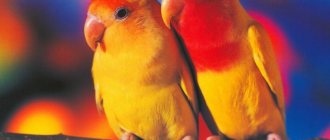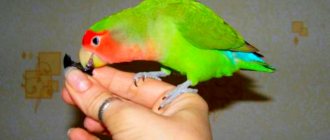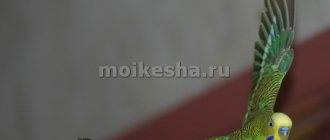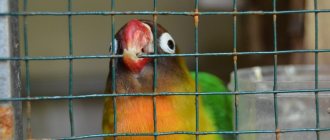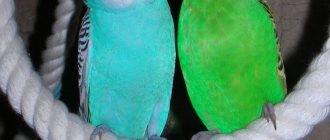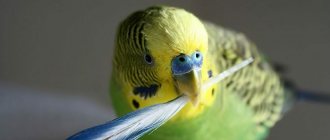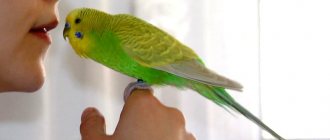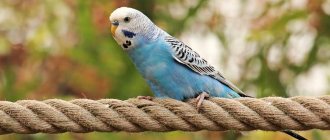Every owner needs to know how old (months) his parrot is. Such information can be of great importance to the work of the veterinarian or ornithologist you contact. It is also important to know the age of the lovebird in advance if you want to breed these birds. Otherwise, you simply won’t be able to find a suitable match for your pet. This article will discuss how to determine the age of a lovebird parrot.
Keeping the rosy-cheeked lovebird at home
Rosy-cheeked lovebirds are unpretentious in their maintenance, and the rules for caring for them are very simple. In order for a bird to please your household in a good mood and be a member of the family for many years, you just need to follow simple rules for caring for the bird.
One or two
Most often they are kept in pairs. In this case, the birds focus all their attention on each other, and will make less contact than their lonely relatives. If the bird is kept alone, it will be more willing to make contact with a person, and even attract attention to itself in every possible way with pranks. It doesn’t matter whether one parrot lives in the house or two - the bird will not wither away without a pair, so the name of the species should not be taken as a guide to starting a bird family. It is better not to get a bird of another species at the same time as a lovebird, as it is capable of showing aggression towards other birds, and can even attack and bite its opponent.
The rosy-cheeked lovebird is very easy to tame. To do this, you need to experimentally find out the bird’s favorite treat, then offer the treat through the bars of the cage, later through its door, and when the bird is completely bold - outside the cage. A tamed lovebird considers a person to be his best friend, and will even try to imitate his voice, so a lonely parrot can be taught a few words (subject to regular training, of course).
Nutrition of lovebirds and selection of food
Lovebirds have a very fast metabolism. They need no more than 3 hours to digest food. Therefore, they will eat often, and it is advisable that their diet be varied in micronutrients.
The diet of parrots must contain food of plant origin. You can buy a ready-made menu, or you can “assemble” it yourself by grinding seeds and dried fruits in a coffee grinder or blender.
Please note: food for regular budgies is not suitable for the lovebird species. For them, you should choose special food, or there should be o. Millet should predominate in the grain feed. This is the basis of lovebird nutrition and without it the bird can get sick.
In the future, when changing food, introduce the new product gradually - a sudden change in food may cause stomach problems for your parrot.
Sometimes it is acceptable to add nuts and corn to the food. But do not abuse this, because their excess causes obesity in birds.
The amount of food should not exceed 3-4 teaspoons per day.
Parrots also love greens. Try to include it in the diet as often as possible, but if you have indoor plants, make sure that the bird does not feast on them. You can offer the bird leaves of currants, dandelions and clover in any quantity.
Additionally, it will be useful to treat your feathered friend with food chalk, vegetables and fruits. They can be placed in the bars of the cage or crushed into food.
Parrots are very fond of cucumbers, pears, apples and various berries.
In addition, they are saturated with useful microelements that will only benefit him.
The cage and its place
Parrots come from countries with hot and humid climates, so damp and cold rooms are not suitable for keeping birds. You need to choose a warm place with non-dry air (that is, installing the cage next to the battery is not the best idea). It is also best to avoid direct sunlight; it is good if the sun only partially enters the cage, and the parrot has the opportunity to fly into the shade. Drafts, stuffiness and cigarette smoke are deadly factors for lovebirds. They definitely need to be avoided. The size of the cage must be at least 80*45*50 centimeters, the width between the rods of the cage must not be more than 1.5 cm, and the structure itself must be made of light metal. You can place popular bird accessories in the cage - houses, mirrors, bells. But the main thing here is not to overdo it, since the bird loves space to fly.
You definitely need to put a container with water, because lovebirds are very partial to water procedures. It is better to purchase a bird feeder so that your feathered friend does not overturn the bowl of grain. In addition, you need:
- chalk or chalk stone (to sharpen beak, claws, and as an additional source of calcium);
- always clean and fresh water;
- river sand (to improve digestion).
In addition, you can buy special treats for birds. They are made in the form of sticks with a hook, on which grains, berries and small flowers are stuck using honey.
Lifestyle in nature
The habitat of this species is South-West Africa (Namibia, South Africa, Angola), the island of Madagascar. They are accustomed to a hot climate.
Lovebirds are gregarious and sedentary birds. They gather in groups of up to 20 individuals and prefer to inhabit areas near water sources.
Interesting! Pink-headed lovebirds move briskly along the ground, often preferring to do so sideways.
African rose-cheeked parrots are believed to be able to live up to 20 years, although there is an undocumented case of one centenarian who lived to be 34 years old.
They feed on everything that makes up the diet of other birds:
- berries,
- flowers,
- millet,
- fruits (both wild plants and cultivated ones),
- maize seeds, sunflower seeds,
- nuts,
- grain.
Feeding
The diet of parrots must contain special food. It is better to purchase mixtures designed specifically for this species. You can also give:
- fresh herbs (with the exception of parsley - this is poison for the lovebird);
- small pieces of fruits and vegetables (pears, apples, carrots);
- berries;
- eggshells (during reproduction).
Young parrots eat often, sometimes up to 5-6 times a day. Adults eat only once.
Determination methods
Each lovebird has a piece of skin above the beak on which the nostrils are located - this is the so-called “cere”. Young birds have a dark-colored cere. As it gets older, when the feathered pet is about three months old, it becomes lighter.
The color of the feathers can also roughly determine the age of the lovebird. Juveniles have green feathers with a grayish tint. After six months, lovebirds lose the gray tint on their green feathers. In this place there are now feathers of a single green color.
If you have a young Black-winged Lovebird, it will lack the red plumage on its head. The masked species of these birds, less than a month old, has a black spot above the beak. Other species retain the spot for a maximum of two months. Lovebirds with the lutino mutation do not have spots, so this method will not help.
Features of behavior
Rosy-cheeked lovebirds are most often preferred for keeping at home. And this is not surprising, because they do not require complex care. However, there are also nuances. Birds are often given as a gift, or bought spontaneously, without first studying the characteristics of the species. Therefore, those who already have such a feathered pet are strongly advised to first get acquainted with the list of possible difficulties, and only then buy a bird.
Of the most important features of keeping lovebirds, the first and most important is their very loud cry. Very, very loud! You should pay special attention to this before entering the establishment, because the cries of rosy-cheeked lovebirds are not at all melodious. A loud, shrill and constant squealing is what everyone who plans to keep this parrot at home should be aware of. Therefore, if you have weak nerves, a small child who needs silence to sleep, or poor hearing in the apartment, you should think carefully. Otherwise, later the unfortunate bird will have to be re-gifted and rehomed, but we are responsible for those we have tamed. You can calm down a raging parrot by taking the cage with it into a dark room (a bathroom or bedroom with thick curtains is ideal for this). Some owners advise covering the cage with a blanket, but this is still not worth doing - the bird may suffocate.
The second feature of keeping it is the birds’ free flights around the apartment. A mobile and active bird needs daily flights around the premises, and even a relatively large cage will not be suitable for this purpose. The most ideal conditions for a lovebird are when the cage door is constantly open, and he can fly into it to eat or sleep. Therefore, surprises in the form of “bombs” are inevitable. Repairs in the apartment will also suffer - parrots love to sharpen their beaks on anything they like, tear off wallpaper and even swing on curtains, catching on their sharp claws. The lovebird is mischievous, but at the same time incredibly charming, and you can forgive him for the spoiled interior. The contact bird will become both a companion and an alarm clock, and will make you smile more than once with its cute tricks.
And lastly, you need to remember that the bird has its own character. Lovebird babies are very curious and sociable, so they constantly require attention. Due to frequent overexcitement, they can rush around the room like crazy, knocking over small objects and scattering feathers. If there are other pets in the house, it is possible that the little bullies will tease their competitors, peck and offend them.
An exception
There are individuals whose age can be determined by external signs even for an experienced poultry farmer. These include:
- Lutino parrots;
- Albinos;
- Clean parrots;
- Repressively variegated.
The first ones have red eyes, which remain with them throughout their lives. And the latter have a cere that does not change throughout life. With rare exceptions, this part of the beak of females becomes somewhat darker.
Light “mutants” are generally devoid of all pigmentation characteristics, which is why it is difficult to determine their age. Black pigments are often lost, without which the wavy does not look like itself. However, there are still parameters regarding the size of the body and the skin of the paws. The latter is often more correct, because it does not depend in any way on the plumage.
How to determine the age of a rosy-cheeked lovebird
If you have already acquired a feathered friend, but do not know his past, then you have probably already asked yourself the question - how then can you determine the age of a rosy-cheeked lovebird? The most important sign is the bird's beak. In young parrots it is smooth, without damage. The older the bird, the more powerful the beak, and the more chips there are on it. Young rosy-cheeked lovebirds have black speckled beaks, but with age they become a pure straw color. If the wax above the beak is light, then the baby is no more than 3 months old. When brighter plumage appears in a young-looking parrot after a heavy moult, we can conclude that it is a little more than six months old (the time of its first molt). The feet of young birds are smoother and acquire scales only after 6 months.
Appearance
The parrot is small in size - 15-17 cm and weighs up to 60 grams. The wingspan is about 25 cm. Its color is remarkable: the body is a bright green grass color, the tail has bright blue feathers. The forehead, cheeks and neck are colored peachy-pink, for which it is also called the pink-headed one. Sometimes the shade of the cheeks reaches red, and then it is already a red-cheeked parrot.
The traditional color of these birds has been diluted by breeders into many color mutations. There are blue, yellow, orange, gray, spotted, cream, green-olive, pastel blue, lutino, white, purple and other (over 60 mutations in total) rosy-cheeked lovebirds. In terms of variety of colors, only budgies overtook them.
The popularity of such bright colors does not allow breeders to stop and they are constantly trying to breed new mutations. After all, the unusual color of the rosy-cheeked parrot makes it possible to set a higher price for it.
How to distinguish a female rosy-cheeked lovebird from a male
If you put two same-sex lovebirds in a cage, then you definitely won’t be able to avoid conflicts. Therefore, you definitely need to know how to distinguish a male from a female rosy-cheeked lovebird. Girls are usually slightly larger than boys, their heads are flatter, and the back of their heads is angular. The beak of girls is slightly smaller and lighter. In males, the pelvic bones are closer to each other. Females hatch eggs, and therefore their pelvis is designed by nature to be wider. Even the gait and sitting on the perch are different - a girl will spread her paws wider than a boy. If it is not possible to determine visually, then the bones can be carefully felt in the area of the cloaca; to do this, the bird must be placed on your hand with its belly up.
Reproduction in the natural environment
Puberty in individuals occurs at 8-12 months.
The construction of the nest is done by the female. She places tree bark, grass, twigs, and leaves on the bottom. In this case, all the building material is carried in the uppertail feathers. At this time, the male guards the future nesting site and looks for food for the female.
The clutch is made of 4-6 round white eggs. Each egg is laid at intervals of 1-2 days. Incubation lasts 23 days.
The chicks are born deaf, naked and blind. However, after a month they become fully fledged. Around this time, the chicks begin to fly out of the nest. True, they are fed by their parents for another two weeks.
After six months, the chicks begin to molt and change their dull plumage to brighter ones. 8-month-old chicks no longer differ in color from adults.
Listen to how beautifully these handsome rosy-cheeked lovebirds sing and chirp:
Causes of early death
Parrots are very inquisitive by nature; they definitely need to inspect everything while flying around the room. Therefore, you need to monitor them carefully: they can get injured by hitting a wall.
If there is a wire in a visible place, they will certainly try to bite it. There is no need to leave food available - they can overeat and get poisoned. And an open window is completely taboo - it is very rare to catch a parrot after escaping.
The females need to be monitored in between laying eggs - they need to recover, so sometimes it is necessary to separate them from the males into another cage.
Lovebirds need attention, the owner must talk to them and show care. These birds wither away from depression as quickly as from poor nutrition. The same applies to excessive noise - only calm and relative silence.
Lovebird parrot cost
As a rule, Fischer's lovebirds are kept as pets, although masked and red-cheeked lovebirds are no less popular. Their estimated cost does not exceed 2 and a half thousand rubles. According to some observations, red-cheeked lovebirds are the cheapest among them, but Fischer's lovebirds and masked lovebirds can cost a little more.
